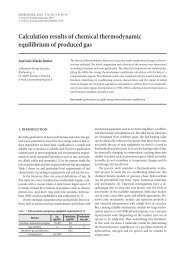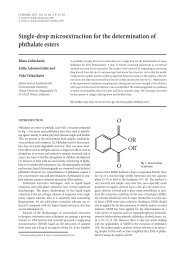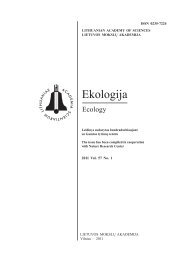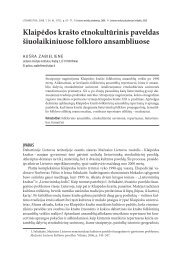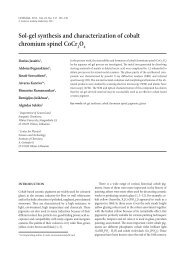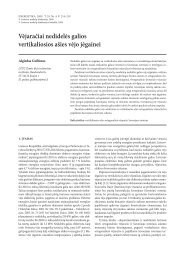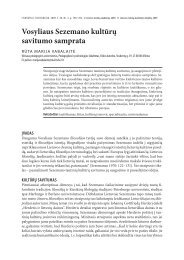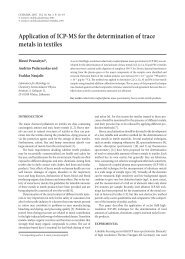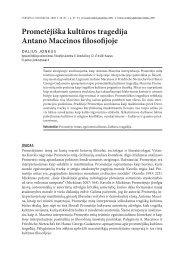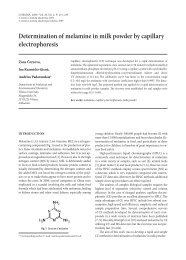St. Bruno. A Miracle in the Church: investigation of the painting ...
St. Bruno. A Miracle in the Church: investigation of the painting ...
St. Bruno. A Miracle in the Church: investigation of the painting ...
Create successful ePaper yourself
Turn your PDF publications into a flip-book with our unique Google optimized e-Paper software.
36Jurga Bagdzevičienė, <strong>St</strong>asys TautkusFig. 3. FTIR spectra <strong>of</strong> restoration adhesive and v<strong>in</strong>yl acetate etilene copolymer (VAE)Fig. 4. <strong>St</strong>ratigraphic view <strong>of</strong> light grey pa<strong>in</strong>t (No. 1) sample, magnification 320×: a) visible light, b) UV lighta light grey pa<strong>in</strong>t, consist<strong>in</strong>g <strong>of</strong> two layers <strong>of</strong> different bluecolours: light greyish and dark blue vitreous smalt particlesmixed with a white pigment.The results <strong>of</strong> SEM / EDX analysis <strong>of</strong> <strong>the</strong> light grey pa<strong>in</strong>t(No. 1) at different cross-section po<strong>in</strong>ts are listed <strong>in</strong> Table 1.The stratigraphic description <strong>of</strong> <strong>the</strong> light grey pa<strong>in</strong>t sampleafter <strong>the</strong> microchemical qualitative and EDX analysis hasbeen summarized as follows:I. The first layer is a brown-red ground that conta<strong>in</strong>s naturalchalk, ochre, lead white, m<strong>in</strong>ium and black carbon pigments.II. The second layer is an orig<strong>in</strong>al layer <strong>of</strong> a dark bluepa<strong>in</strong>t, which consists <strong>of</strong> smalt and lead white pigments aswell as chalk as small impurities.III. The third layer is an orig<strong>in</strong>al layer <strong>of</strong> a light greyishpa<strong>in</strong>t which conta<strong>in</strong>s smalt and lead white pigments. It alsoconta<strong>in</strong>s small amounts <strong>of</strong> chalk impurities.Table 1. SEM / EDX elemental composition <strong>of</strong> <strong>the</strong> light grey pa<strong>in</strong>t (No. 1) sample at different cross-section po<strong>in</strong>ts (wt%)Pa<strong>in</strong>tlayersMg Al Si Cl K Ca Fe Pb Co Ni AsGround 1a 1.38 1.8 4.09 0.00 0.95 79.63 4.15 7.91 – – –Ground 1b – 1.50 13.50 0.36 0.88 72.84 4.20 6.73 – – –Ground 1c – – 0.83 – – 4.26 0.83 94.09 – – –Pa<strong>in</strong>t layer 2a – 1.18 24.75 – 5.09 4.87 1.75 59.07 1.80 1.13 0.35Pa<strong>in</strong>t layer 2b – 1.67 65.00 – 14.53 2.76 2.08 10.18 3.29 – 0.51Pa<strong>in</strong>t layer 3a – 1.47 59.41 – 24.97 2.06 1.56 7.34 2.28 – 0.92Pa<strong>in</strong>t layer 3b – 1.15 20.56 – 1.81 9.20 0.77 65.95 0.57 – 0.00Pa<strong>in</strong>t layer 3c – 1.57 54.52 – 25.37 2.45 2.08 9.86 3.30 – 0.85
<strong>St</strong>. <strong>Bruno</strong>. A <strong>Miracle</strong> <strong>in</strong> <strong>the</strong> <strong>Church</strong>: <strong>in</strong>vestigation <strong>of</strong> <strong>the</strong> pa<strong>in</strong>t<strong>in</strong>g technique37The identified smalts <strong>of</strong> different colours (<strong>the</strong> 2nd and3rd layers) conta<strong>in</strong> a different amount <strong>of</strong> potassium, <strong>in</strong>dicat<strong>in</strong>gthat <strong>the</strong> processes <strong>of</strong> smalt production was different [8].Moreover, <strong>the</strong> stability <strong>of</strong> smalt decreases as <strong>the</strong> content <strong>of</strong>K 2O <strong>in</strong>creases. This may expla<strong>in</strong> <strong>the</strong> different resistance <strong>of</strong>smalt to atmospheric conditions when its pal<strong>in</strong>g and grey<strong>in</strong>gare observed [9]. In our case, it is possible to expla<strong>in</strong> <strong>the</strong> grey<strong>in</strong>g(clear<strong>in</strong>g) <strong>of</strong> <strong>the</strong> third layer <strong>of</strong> pa<strong>in</strong>t because <strong>in</strong> this layer<strong>the</strong> smalt conta<strong>in</strong>ed more potassium. Both layers <strong>of</strong> pa<strong>in</strong>t areorig<strong>in</strong>al and have no streak <strong>of</strong> varnish. Smalt is potassiumglass pa<strong>in</strong>ted with cobalt oxide conta<strong>in</strong><strong>in</strong>g various impurities:SiO 266–72%, K 2O 10–21%, CoO 2–18%, As 2O 30–8%, aswell as small amounts <strong>of</strong> calcium, manganese, iron, nickel ando<strong>the</strong>r oxides. This pigment was produced s<strong>in</strong>ce <strong>the</strong> 15th century<strong>in</strong> Venice, Czechia and The Ne<strong>the</strong>rlands and was widelyused <strong>in</strong> distemper, oil and wall pa<strong>in</strong>t<strong>in</strong>gs [10].Fig. 5. <strong>St</strong>ratigraphic view <strong>of</strong> blue-brownish pa<strong>in</strong>t (No. 5) sample, magnification225×: a) visible light, b) UV lightA photograph <strong>of</strong> <strong>the</strong> stratigraphic image <strong>of</strong> <strong>the</strong> bluebrownish(No. 5) pa<strong>in</strong>t sample is given <strong>in</strong> Fig. 5. It is possibleto conclude that <strong>the</strong> pa<strong>in</strong>t sample consists <strong>of</strong> four layers <strong>of</strong>pa<strong>in</strong>t<strong>in</strong>g: <strong>the</strong> layer <strong>of</strong> a brown-red ground <strong>of</strong> uneven thickness,two layers <strong>of</strong> different blue-brownish colours <strong>of</strong> uneventhickness, and a layer <strong>of</strong> varnish.The results <strong>of</strong> SEM / EDX analysis <strong>of</strong> <strong>the</strong> blue-brownishpa<strong>in</strong>t sample at different cross-section po<strong>in</strong>ts are listed <strong>in</strong>Table 2. The stratigraphic description <strong>of</strong> <strong>the</strong> blue-brownishpa<strong>in</strong>t sample after summariz<strong>in</strong>g <strong>the</strong> results <strong>of</strong> microchemicalqualitative and EDX analysis is as follows:I. The first layer is a brown-red ground that <strong>in</strong>cludes naturalchalk, ochre, lead white, m<strong>in</strong>ium and black carbon pigments.II. The second layer is an orig<strong>in</strong>al layer <strong>of</strong> a brown-bluepa<strong>in</strong>t which <strong>in</strong>cludes smalt (CoO · K 2SiO 3) <strong>in</strong> lead white pigmentwith azurite and chalk as small impurities.III. The third layer is an orig<strong>in</strong>al layer <strong>of</strong> a bluish-brownishpa<strong>in</strong>t, which conta<strong>in</strong>s azurite (2CuCO 3· Cu(OH) 2) <strong>in</strong> leadwhite pigment and chalk as small impurities.IV. The fourth layer is varnish.The layer <strong>of</strong> <strong>the</strong> blue-brownish pa<strong>in</strong>t consists <strong>of</strong> twolayers <strong>of</strong> pa<strong>in</strong>t <strong>of</strong> a different chemical composition. Thebottom layer conta<strong>in</strong>s cleared greyish smalt which is quiteeasily recognisable from elongated, sharp particles withvisible broken edges [11], mixed with a pigment <strong>of</strong> brightblue azurite and lead white pigment, and <strong>the</strong> top layer isdom<strong>in</strong>ated by bright blue, roughly ground particles <strong>of</strong> <strong>the</strong>azurite pigment mixed with lead white pigment. IR spectroscopicanalysis confirmed <strong>the</strong> presence <strong>of</strong> azurite pigment<strong>in</strong> <strong>the</strong> blue pa<strong>in</strong>t. The visible brown<strong>in</strong>g <strong>of</strong> <strong>the</strong> bluepa<strong>in</strong>t layer was caused by <strong>the</strong> b<strong>in</strong>d<strong>in</strong>g materials <strong>of</strong> <strong>the</strong> pa<strong>in</strong>tand <strong>the</strong> fact that <strong>the</strong> layer <strong>of</strong> varnish cover<strong>in</strong>g <strong>the</strong> pa<strong>in</strong>t hadyellowed.Such a comb<strong>in</strong>ation <strong>of</strong> two layers <strong>of</strong> a blue pa<strong>in</strong>t <strong>in</strong> pa<strong>in</strong>t<strong>in</strong>gshas been known from <strong>the</strong> 15th century written sourcesand <strong>the</strong> peculiarities <strong>of</strong> pa<strong>in</strong>t<strong>in</strong>g techniques <strong>of</strong> certa<strong>in</strong> periods,which were partially determ<strong>in</strong>ed also by <strong>the</strong> economicconditions <strong>of</strong> <strong>the</strong> time: due to wars <strong>in</strong> Turkey it was difficultto import natural ultramar<strong>in</strong>e and azurite to Europe; thus,smalt was used more widely [8, 12]. The <strong>in</strong>expensive smaltpigment, <strong>the</strong> ground melt <strong>of</strong> quartz sand, potash and cobalt,Table 2. SEM / EDX elemental composition <strong>of</strong> <strong>the</strong> blue-brownish (No. 5) pa<strong>in</strong>t sample at different cross-section po<strong>in</strong>ts (wt%)Pa<strong>in</strong>tlayersMg Al Si Cl K Ca Fe Cu Pb PGround 1a – 1.42 5.14 – 1.27 74.88 6.15 1.18 9.96 –Ground 1b – – – – – 3.85 0.66 0.80 94.69 –Ground 1c 2.45 1.51 2.60 – – 32.30 6.45 2.66 52.03 –Ground 1d 1.20 2.50 4.85 6.41 0.72 76.87 3.91 1.51 7.15 1.29Pa<strong>in</strong>t layer 2a 1.63 2.12 8.87 – 2.68 4.85 1.23 32.29 39.93 –Pa<strong>in</strong>t layer 2b – 1.17 2.56 3.19 0.69 5.34 0.57 73.74 12.74 –Pa<strong>in</strong>t layer 2c 1.01 1.49 17.75 4.62 2.52 8.55 1.80 31.12 31.13 –Pa<strong>in</strong>t layer 3a – – 1.73 7.50 0.19 1.64 0.72 80.68 7.55 –Pa<strong>in</strong>t layer 3b – 0.49 1.52 9.18 – 2.05 0.69 65.93 20.13 –
38Jurga Bagdzevičienė, <strong>St</strong>asys Tautkushad a tendency to turn pale and grey, especially if ground to<strong>of</strong><strong>in</strong>ely, or when its production processes were not technologicallysound and too much potash had been added <strong>in</strong>to <strong>the</strong>melted mixture. Thus, smalt used to be mixed with brightblue but much more expensive pigments: ultramar<strong>in</strong>e andazurite [13].A photograph <strong>of</strong> <strong>the</strong> stratigraphic image <strong>of</strong> a yellowishpa<strong>in</strong>t (No. 7) sample is shown <strong>in</strong> Fig. 6. It is possible to assumethat <strong>the</strong> sample consists <strong>of</strong> four layers <strong>of</strong> pa<strong>in</strong>t. TheSEM / EDX results <strong>of</strong> <strong>the</strong> yellowish pa<strong>in</strong>t at different crosssectionpo<strong>in</strong>ts are listed <strong>in</strong> Table 3.The stratigraphic description <strong>of</strong> <strong>the</strong> yellowish pa<strong>in</strong>t sampleafter summariz<strong>in</strong>g <strong>the</strong> results <strong>of</strong> microchemical qualitativeand EDX analysis are as follows:I. The first layer is a layer <strong>of</strong> brown-red ground, whichconta<strong>in</strong>s natural chalk, ochre, lead white, m<strong>in</strong>ium and carbonpigments.II. The second layer is a brown layer that conta<strong>in</strong>s naturalchalk, ochre (<strong>in</strong>clud<strong>in</strong>g Mn), lead white, m<strong>in</strong>ium and auripigment(As 2S 3) pigments.III. The third layer is an orig<strong>in</strong>al brown layer <strong>of</strong> pa<strong>in</strong>t,which conta<strong>in</strong>s natural chalk, ochre (<strong>in</strong>clud<strong>in</strong>g Mn) and leadwhite pigments.IV. The fourth layer is a yellowish layer <strong>of</strong> pa<strong>in</strong>t that conta<strong>in</strong>slead t<strong>in</strong> yellow (Pb 2SnO 4) and lead white pigments.Micro-XRD analysisThe micro-XRD analysis <strong>of</strong> yellowish pa<strong>in</strong>t (No. 7, <strong>the</strong>fourth layer) has allowed us to establish that <strong>the</strong> yellowpigment is lead t<strong>in</strong> yellow (Pb 2SnO 4) type I. Its X-ray diffractionpattern is shown <strong>in</strong> Fig. 7. Three phases have beenidentified <strong>in</strong> <strong>the</strong> X-ray diffraction pattern <strong>of</strong> <strong>the</strong> yellowishpa<strong>in</strong>t and attributed to lead t<strong>in</strong> oxide (Pb 2SnO 4) (JCPDSNo. 24-0589), lead white pigment consist<strong>in</strong>g <strong>of</strong> hydrocerussite((2PbCO 3· Pb(OH) 2)) (JCPDS No. 13-0131) and cerussite(PbCO 3) ((JCPDS No. 47-1734). After <strong>the</strong> XRD analysis<strong>of</strong> several pa<strong>in</strong>t<strong>in</strong>g samples from <strong>the</strong> Renaissance period,researchers [14] have discovered that <strong>the</strong> ratio <strong>of</strong> two leadcarbonate phases (hydrocerussite and cerussite) found <strong>in</strong><strong>the</strong> composition <strong>of</strong> <strong>the</strong> pa<strong>in</strong>t may be very different depend<strong>in</strong>gon a sample and could be characteristic <strong>of</strong> a certa<strong>in</strong> period,technical knowledge <strong>of</strong> how to produce this pigment,and its geographical orig<strong>in</strong>. Moreover, <strong>the</strong>se data may berelated to <strong>the</strong> conditions <strong>of</strong> chemical syn<strong>the</strong>sis and preparation<strong>of</strong> lead carbonates.The lead t<strong>in</strong> yellow pigment can be <strong>of</strong> two types: lead t<strong>in</strong>Fig. 6. <strong>St</strong>ratigraphic view <strong>of</strong> yellowish pa<strong>in</strong>t (No. 7) sample, magnification 225 ×:a) visible light, b) UV lightyellow type I (Pb 2SnO 4) and lead t<strong>in</strong> yellow type II (PbSn Si 0 1-) The lead t<strong>in</strong> yellow type I pigment had been widelyx x 3used <strong>in</strong> pa<strong>in</strong>t<strong>in</strong>g s<strong>in</strong>ce 1300, but it had been also used <strong>in</strong>Table 3. SEM / EDX elemental composition <strong>of</strong> yellowish pa<strong>in</strong>t (No. 7) sample at different cross-section po<strong>in</strong>ts (wt%)Pa<strong>in</strong>tlayersMg Al Si K Ca Fe As Pb P Ti S Mn SnGround 1a 2.09 2.53 8.08 1.01 69.12 6.32 – 10.85 – – – – –Ground 2a 0.78 6.40 11.55 0.89 50.45 9.22 – 18.88 1.25 0.58 – – –Ground 2b – – – – 4.73 0.42 – 93.85 – – – – –Ground 2c – – 1.07 – 2.83 0.91 45.61 – – – 49.58 – –Ground 2d – 5.31 6.70 1.51 17.65 5.47 – 63.36 – – – – –Ground 2e 1.65 4.31 13.51 1.07 35.47 16.73 – 20.38 4.21 0.75 – 1.91 –Ground 2f – 2.27 4.39 – 11.48 4.20 – 77.67 – – – – –Pa<strong>in</strong>t layer 3a – – 92.02 – 2.09 0.91 – 4.98 – – – – –Pa<strong>in</strong>t layer 3b 1.40 3.74 8.93 0.93 40.29 16.08 – 24.08 2.27 0.90 – 1.38 –Pa<strong>in</strong>t layer 4a – 5.20 8.56 – 3.28 3.87 – 72.36 – – – – 6.74Pa<strong>in</strong>t layer 4b – 2.03 4.56 – 2.48 1.58 – 69.16 – – – – 20.20Pa<strong>in</strong>t layer 4c – – 0.84 – 2.51 0.86 – 54.26 – – – – 41.53Pa<strong>in</strong>t layer 4d – – 0.87 – 1.77 1.13 – 96.23 – – – – –Pa<strong>in</strong>t layer 4e – – 2.61 – 5.92 2.73 – 88.74 – – – – –
<strong>St</strong>. <strong>Bruno</strong>. A <strong>Miracle</strong> <strong>in</strong> <strong>the</strong> <strong>Church</strong>: <strong>in</strong>vestigation <strong>of</strong> <strong>the</strong> pa<strong>in</strong>t<strong>in</strong>g technique39Fig. 7. X-ray diffraction pattern <strong>of</strong> yellow layer(4th layer, Fig. 6a) <strong>of</strong> yellowish pa<strong>in</strong>t sample No. 7glass mak<strong>in</strong>g s<strong>in</strong>ce ancient times as a means to cloud <strong>the</strong>glass and a yellow pigment to pa<strong>in</strong>t <strong>the</strong> glass, and also whenproduc<strong>in</strong>g <strong>the</strong> lead t<strong>in</strong> yellow type II pigment [15–18].ConclusionsA comb<strong>in</strong>ation <strong>of</strong> microchemical qualitative analysis, opticalmicroscopy, spectroscopic and micro-XRD analyticalmethods has been used to identify pigments and materialsused dur<strong>in</strong>g previous restorations. IR spectroscopic andmicrochemical qualitative analysis data showed that adhesives<strong>of</strong> several k<strong>in</strong>ds were used for l<strong>in</strong><strong>in</strong>g, fold<strong>in</strong>g andglu<strong>in</strong>g <strong>the</strong> patches which had been used dur<strong>in</strong>g previousrestorations.Based on <strong>the</strong> results <strong>of</strong> stratigraphic analysis <strong>of</strong> <strong>the</strong> sampleswith an optical microscope, <strong>the</strong> structure <strong>of</strong> pa<strong>in</strong>t<strong>in</strong>g, <strong>the</strong>order <strong>of</strong> <strong>the</strong> ma<strong>in</strong> layers <strong>of</strong> pa<strong>in</strong>t<strong>in</strong>g, <strong>the</strong> distribution <strong>of</strong> pigmentsand colours have been described. The SEM / EDX andmicro-XRD analysis confirmed that <strong>the</strong> pa<strong>in</strong>t<strong>in</strong>g was pa<strong>in</strong>tedon a ground that conta<strong>in</strong>s natural chalk, ochre, lead white,m<strong>in</strong>ium and black carbon pigments. Smalt, azurite, lead t<strong>in</strong>yellow type I pigments as well as a lead white pigment, whichis a mixture <strong>of</strong> hydrocerussite and cerussite, have been identified.Received 9 June 2010Accepted 28 June 2010References1. R. Janonienė, Menotyra, 3, 3 (2002).2. R. Janonienė, Menotyra, 2, 33 (1999).3. A. Paliušytė (ed.), Lietuvos dail<strong>in</strong><strong>in</strong>kų žodynas, I t., XVI–XVII a., Vilnius (2005).4. M. Shre<strong>in</strong>er, M. Melcher, K. Uhlir, Anal. Bioanal. Chem.,387, 737 (2007).5. M. R. Derick, D. <strong>St</strong>ulik, J. M. Landry, Infrared Spectroscopy<strong>in</strong> Conservation Science, GCI, Los Angeles (1999).6. J. Thomas, S. Learner, Analysis <strong>of</strong> Modern Pa<strong>in</strong>ts, GCI, LosAngeles (2004).7. H. Kühn, H. Rooser-Runge, R. E. <strong>St</strong>raub, M. Koller, ReclamsHandbuch der kunstlerischen Techniken 1, Philipp Reclamjung., <strong>St</strong>uttgart (1997).8. B. Mühlethaler, J. Thissen, Smalt, <strong>in</strong> Artist’s Pigments: AHandbook <strong>of</strong> <strong>the</strong>ir History and Characteristics, (ed. A. Roy),Vol. II, 113–129, National Gallery <strong>of</strong> Art, Wash<strong>in</strong>gton(1993).9. P. Santopadre, M. Verita, <strong>St</strong>ud. Conserv., 51, 29 (2006).10. T. Brachert, Lexikon historischer Maltechniken: Quellen–Handwerk–Technologie–Alchemie, Callwey, München(2000).11. M. Gil, M. L. Carvalho, A. Seruya, I. Ribeiro, P. Alves,A. Guilherme, A. Cavaco, J. Mira, A. Candeia, X-RaySpectrometry (2008), Published onl<strong>in</strong>e <strong>in</strong> Wiley InterScience(www.<strong>in</strong>terscience.wiley.com) DOI: 10.1002/xrs.1024.12. R. J. Gettens, <strong>in</strong>: A. Roy (ed.), Artist’s Pigments: A Handbook<strong>of</strong> <strong>the</strong>ir History and Characteristics, Vol. II, 23–36, NationalGalery <strong>of</strong> Art, Wash<strong>in</strong>gton (1993).
40Jurga Bagdzevičienė, <strong>St</strong>asys Tautkus13. A. M. Seldes, J. E. Burucua, M. S. Maier, G. Abad, A. Jauregui,G. Siracusano, JAIC, 38, 100 (1999).14. E. Welcommel, P. Walter, P. Bleuet, J. Hodeau, E. Dooryhee,P. Mart<strong>in</strong>etto, M. Menu, Appl. Phys. A, 89, 825 (2007).15. R. J. H. Clark, L. Cridland, B. M. Kariuki, K. D. M. Harris,R. Withnall, J. Chem. Soc., Dalton Trans., 2577 (1995).16. M. Heck, Th. Rehren, P. H<strong>of</strong>fmann, Archaeometry, 45, 33(2003).17. H. Kühn, Lead t<strong>in</strong> yellow, <strong>in</strong>: A. Roy (ed.), Artist’s Pigments:A Handbook <strong>of</strong> Their History and Characteristics, Vol. II, 83,National Gallery <strong>of</strong> Art, Wash<strong>in</strong>gton: Oxford UniversityPress (1993).18. I. Borgia, B. G. Brunetti, C. Miliani, C. Ricci, C. Seccaroni,A. Sgamellotti, J. Cultur. Herit., 8, 65 (2007).Jurga Bagdzevičienė, <strong>St</strong>asys TautkusPaveikslo Šv. <strong>Bruno</strong>nas. <strong>St</strong>ebuklas bažnyčiojetapybos technikos tyrimasSantraukaAtliktas išsamus 1674 m. Johanno Berchh<strong>of</strong>fo tapyto paveiksloŠv. <strong>Bruno</strong>nas. <strong>St</strong>ebuklas bažnyčioje (Vilniaus Šv. Pranciškaus Asyžiečio(Bernard<strong>in</strong>ų) bažnyčia, Ap. 9152, T 10117, 283 × 281,5 cm)tyrimas. Der<strong>in</strong>ant kelis analiz<strong>in</strong>ius metodus nustatytos ankstesniųrestauravimų metu naudotos medžiagos ir jų poveikis autor<strong>in</strong>eipaveikslo struktūrai, identifikuotas paveikslo gruntas ir pigmentai,aprašyta tapybos struktūra. Atlikus IR spektr<strong>in</strong>ę bei mikrochem<strong>in</strong>ękokyb<strong>in</strong>ę analizę nustatyta, kad paveikslo ankstesnių restauravimųmetu dubliavimui, užlankoms ir lopams klijuoti buvo naudoti keliųrūšių klijai: a) kleisteris, kurio sudėtyje yra miltų klijai, natūraliderva ir kreida; b) raudonas gruntas; c) s<strong>in</strong>tet<strong>in</strong>iai klijai poliv<strong>in</strong>ilacetat<strong>in</strong>ėsdervos pagr<strong>in</strong>du. Remiantis stratigraf<strong>in</strong>ės mėg<strong>in</strong>ių analizės,opt<strong>in</strong>ės mikroskopijos rezultatais aprašyta tapybos struktūra,pagr<strong>in</strong>d<strong>in</strong>ių tapybos sluoksnių eiliškumas ir pigmentų pasiskirstymasbei spalva. Atlikus SEM / EDX bei XRD analizę nustatyta, kadpaveikslas tapytas naudojant gruntą, kurio sudėtyje yra natūralikreida, ochra, šv<strong>in</strong>o baltasis, surikas bei juodas anglies pigmentai.Identifikuoti smaltos, azurito, šv<strong>in</strong>o–alavo geltonojo tipo I pigmentai,taip pat šv<strong>in</strong>o baltojo pigmentas, kuris yra hidroceruzito ir ceruzitomiš<strong>in</strong>ys.



